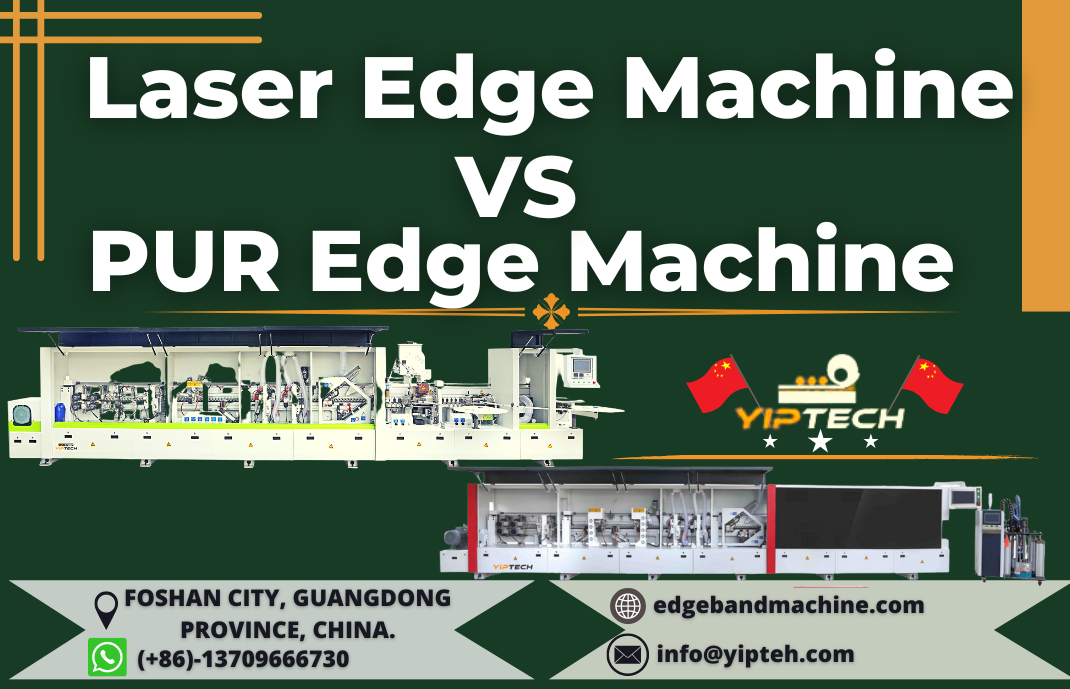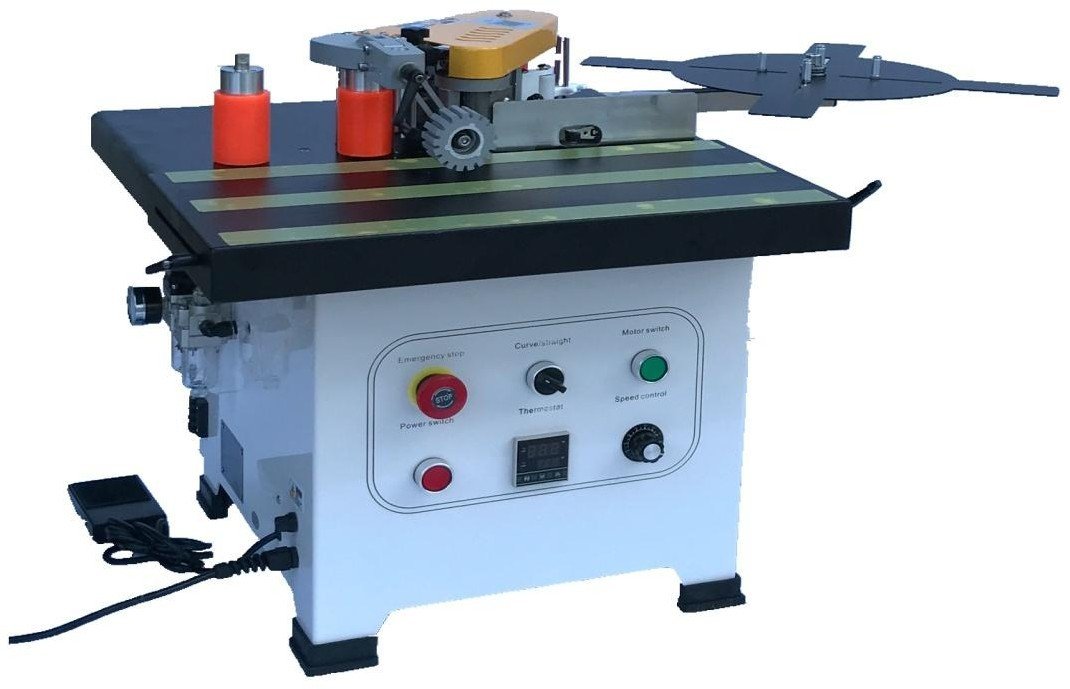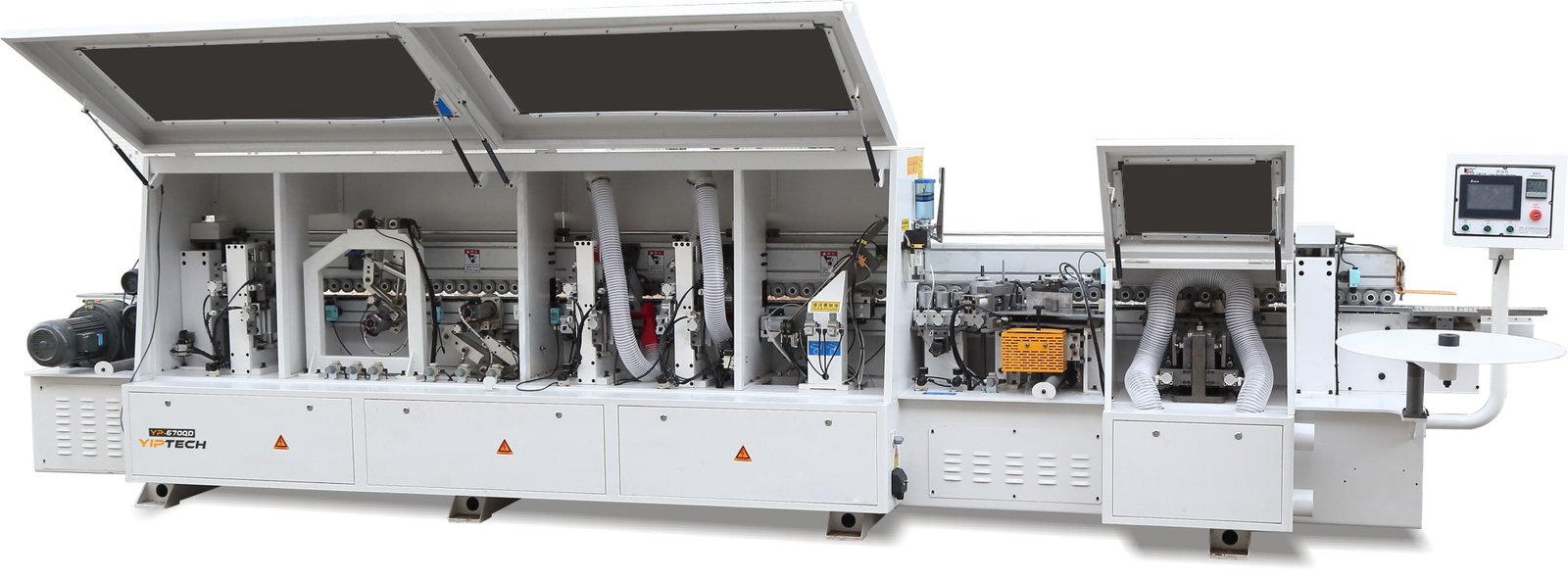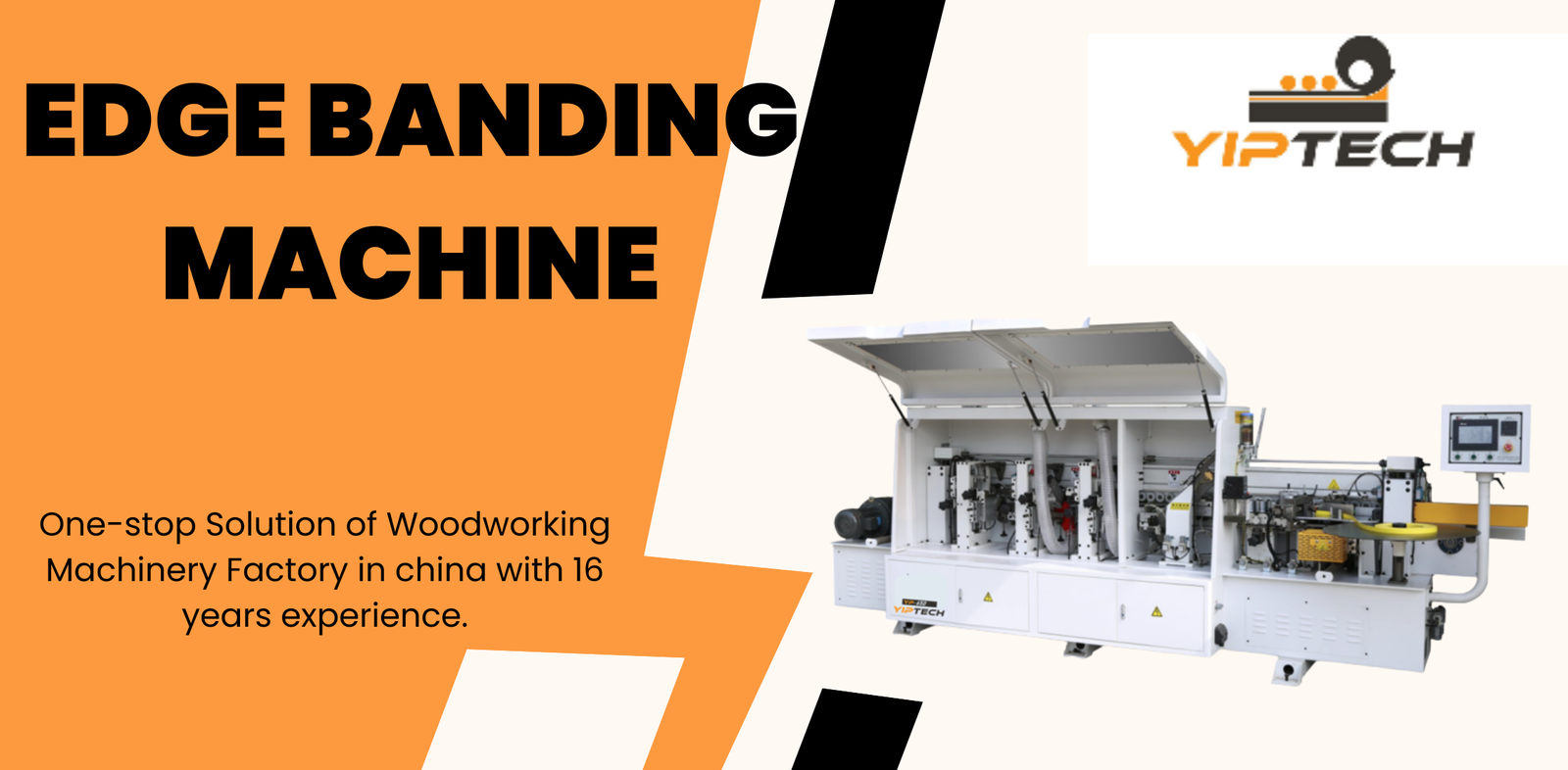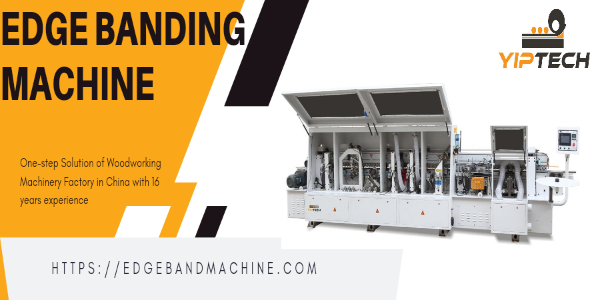Laser Edge Banding
Machines V.S PUR Edge Banding Machines: Comparative Analysis
In furniture and cabinetry manufacturing, applying an edge band to panel edges is crucial for protecting them from wear and tear and enhancing their appearance. There are several machines available on the market, including laser edge banding machines and PUR edge banding machines, each with unique features and benefits.
To help manufacturers make an informed decision, this article will provide a comprehensive comparison between laser machines and PUR machines. We will explore the technology and process behind each machine, their respective advantages and limitations, and the industries and applications that benefit the most from each technology. By understanding the differences between these two machines, manufacturers can make an informed decision on the right edge banding technology that aligns with their specific requirements and preferences.
Overall, this article aims to provide valuable insights to help manufacturers achieve high-quality and durable finished products through the right machine.
Edge banding Machines
Edge Banding Machines are an essential technology in the manufacturing industry, particularly for furniture and cabinetry production. They play a vital role in protecting boards and panels from damage, providing a refined and finished appearance, and strengthening the final product. Banding machines can apply different edge materials, such as wood veneer, PVC, or ABS, depending on the desired look and function.
Explanation of why Edge Banding is important in furniture and cabinetry manufacturing
Edge banding plays a critical role in the manufacturing of furniture and cabinetry, enhancing the visual appeal, functionality, and durability of the finished product. Unprotected edges of panels and boards are prone to wear and tear, chipping, and moisture damage, leading to decreased product lifespan and performance. Banding machines provide a quick and efficient solution by applying banding materials, such as PVC or wood veneer, to the panel edges, protecting them from damage and providing a polished look.
Edge banding is a crucial step in furniture and cabinetry manufacturing, providing numerous benefits such as protection, aesthetics, and customization. Selecting the right machine is essential in achieving high-quality, durable, and aesthetically pleasing products.
Brief overview of the difference between Laser and PUR banding machines
Edge banding technology has evolved over the years, with laser and PUR machines being the most popular. Laser machines use a high-powered laser to melt the material and bond it to the panel edge. On the other hand, PUR machines use a polyurethane hot-melt adhesive to apply the banding material. Understanding the differences between these two technologies can help manufacturers choose the right option for their specific needs and preferences.
Laser Edge Banding Machines
A laser machine plays a crucial role in the manufacturing industry. This machine is specifically designed to apply a thin layer of material, which could be made of PVC, wood veneer, or other materials, to the edges of boards and panels.
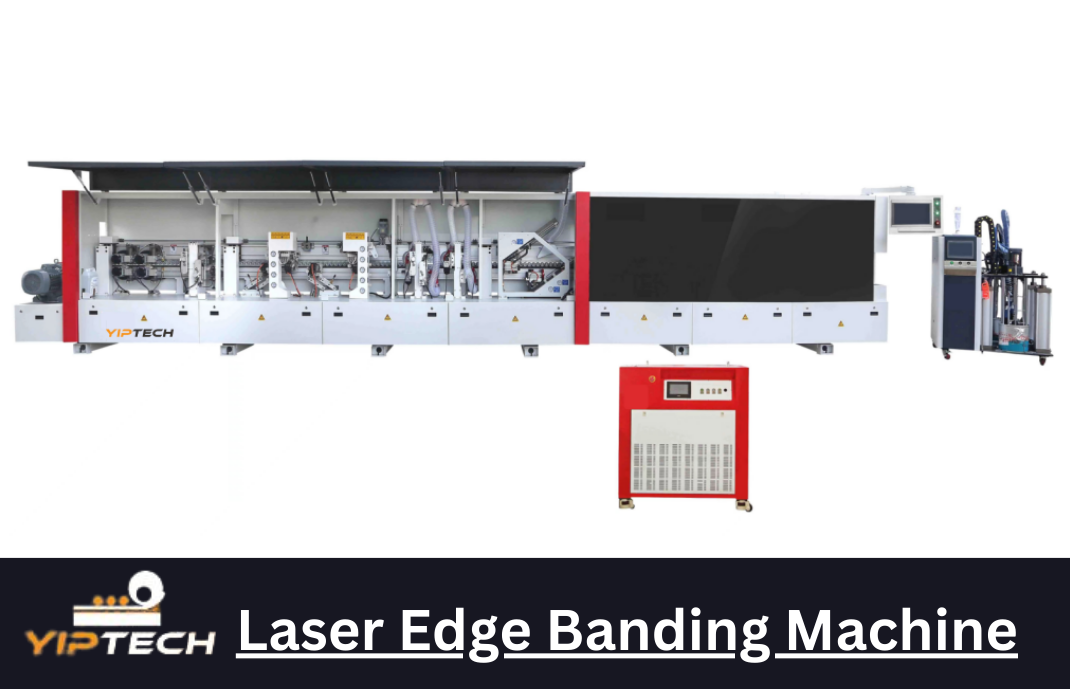
Unlike traditional methods, laser machines use a high-powered laser beam to melt the edge of the material and create a strong and smooth bond with the substrate. This process results in an aesthetically pleasing and durable finish that enhances the product’s value and lifespan. Additionally, laser machines are capable of handling a wide range of materials, including fragile and delicate surfaces, with high precision and accuracy.
Process Of Laser Edge Banding Machines
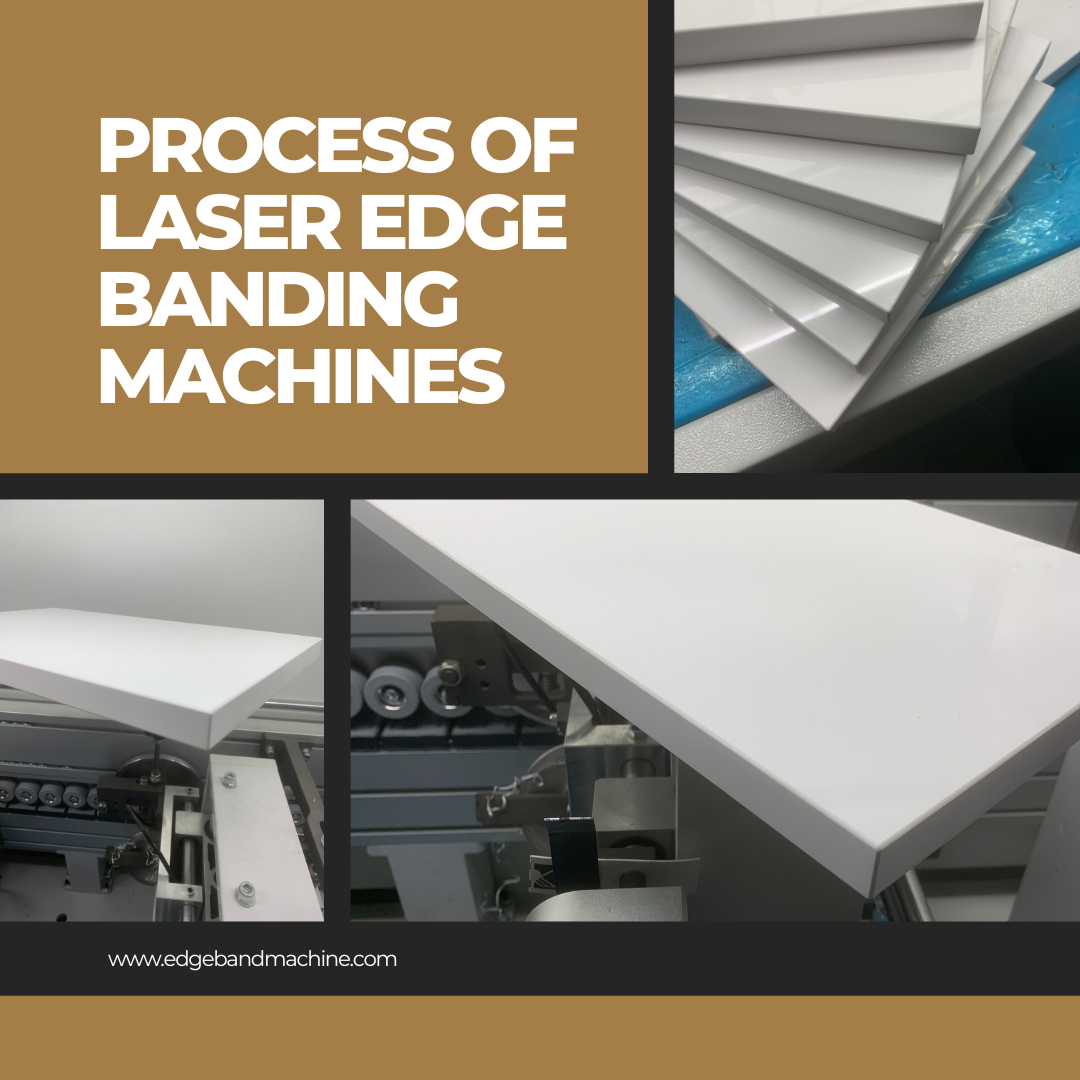
The process of laser edge banding involves several steps, including:
- Panel preparation: Before banding, the panel or board needs to be prepared. The edges are first cleaned and smoothed to ensure proper adhesion of the material.
- Material selection: Banding materials come in a variety of materials, such as PVC, ABS, and wood veneer. The choice of material will depend on the desired finish and functionality of the final product.
- Material feeding: The material is fed into the machine using a feed roller. This roller ensures the material is fed consistently and accurately, preventing any misalignment of the banding material during the process.
- Laser cutting: Once the material has been fed into the machine, the laser beam is used to cut the material to the desired size and shape. The precision of the laser beam ensures that the banding material is cut cleanly and accurately.
- Edge bonding: The final step is the edge bonding process. The laser beam is used to melt the edge of the material, and the melted material is fused to the panel edge, creating a strong and smooth bond. The resulting edge is durable, resistant to moisture, and has a clean and professional finish.
Overall, laser machines offer precise and efficient edge banding, resulting in a high-quality finished product.
Advantages of using Laser Edge Banding Machines
- Precision: Laser machines use high-powered lasers to accurately cut and bond edge banding materials to panel edges. This results in precise and clean cuts, ensuring a perfect edge every time.
- Strength: The fusion of the banding material to the panel creates a strong and durable bond that can withstand heavy use and wear. The smooth bond also provides additional protection against moisture and damage.
- Accuracy: Laser technology offers consistent and accurate application of the banding material, reducing the risk of errors and waste. This results in a more efficient and cost-effective manufacturing process.
- Speed: Laser machines can work quickly and efficiently, saving time and increasing production capacity. The speed and precision of laser technology can significantly reduce production times, allowing manufacturers to produce more products in less time.
- Versatility: Laser machines can work with a variety of materials and panel sizes, making them ideal for a wide range of applications. They can handle materials such as PVC, ABS, wood veneer, and more, making them a versatile option for manufacturers.
Industries and Applications Benefiting from Laser Edge Banding Machines
Laser machines are utilized in various industries and applications where precise, durable, and flawless banding is essential. Here are some of the industries and applications that benefit from laser banding machines:
- Furniture Manufacturing: Laser machines are commonly used in the production of furniture, where they are used to apply decorative and functional edging to panels and boards. The precise and durable bond created by laser banding machines results in a finished product that is not only aesthetically pleasing but also durable and resistant to wear and tear.
- Kitchen and cabinetry manufacturing: Laser machines are also used in the production of kitchen and cabinetry components, where they can be used to create a smooth and durable finish on panels and doors. The use of laser technology ensures that the edge banding is applied precisely and consistently, resulting in a high-quality finished product.
- Automotive manufacturing: Laser machines are used in the production of car interiors, where they can be used to create a smooth and durable finish on panels and components. The precision and durability of laser banding ensure that the finished product can withstand heavy use and wear.
- Electronics manufacturing: Laser edge banding machines can be used in the production of electronic components, where they can be used to create a precise and seamless finish on circuit boards and other components. The accuracy and consistency of laser banding machines make them ideal for working with small and delicate components.
Laser machines are utilized in various industries and applications where precision, durability, and aesthetics are essential. These machines ensure a strong and smooth bond between the edge banding material and the substrate, resulting in a high-quality finished product.
PUR Edge Banding Machines
PUR (Polyurethane Reactive) banding machines are specialized equipment used in the manufacturing industry for applying a high-strength and durable edge to panels and boards. These machines use a hot-melt adhesive made of polyurethane to bond the banding material to the substrate. Unlike traditional methods, the polyurethane adhesive is activated by moisture in the air, creating a chemical bond that is both strong and flexible.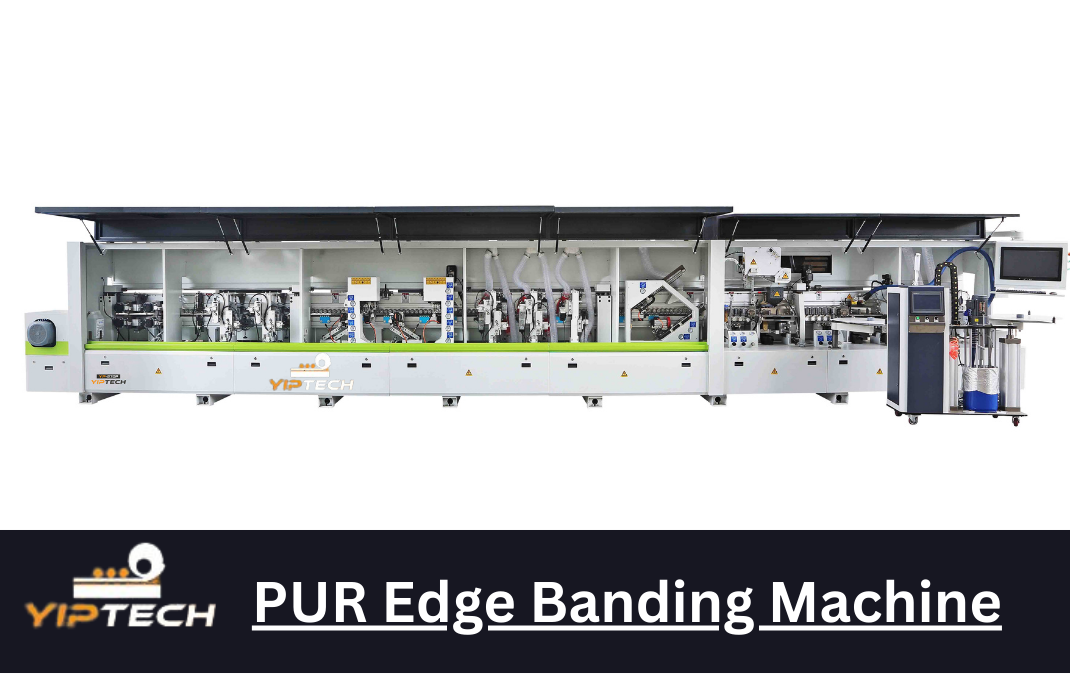
Process of PUR Edge Banding Machine

During the PUR banding process, each step plays a crucial role in ensuring a strong bond between the edge banding and the substrate. Let’s take a closer look at each step:
- Panel preparation: The panel or board to be edged must be properly cleaned and sanded to remove any dirt, dust, or debris that could compromise the adhesion of the edge banding.
- Material selection: The PUR adhesive is chosen based on the desired functionality and finish of the edge banding. PUR adhesive is known for its high strength, durability, and resistance to moisture, heat, and chemicals.
- Material feeding: The PUR adhesive is fed into the machine through a feed roller, which ensures accurate and consistent feeding. The machine’s rollers apply pressure to the adhesive, ensuring a consistent flow.
- Heating: The PUR adhesive is heated to a specific temperature, which varies depending on the material and adhesive used. This process is crucial in preparing the adhesive for application, making it easier to spread and ensuring a strong bond.
- Application: The melted adhesive is applied to the panel edge through an application nozzle, while the banding is applied to the panel. The machine accurately applies the adhesive in a thin and uniform layer, ensuring a strong bond.
- Bonding: The chemical reaction between the adhesive and the substrate creates a strong and durable bond, ensuring long-lasting and high-quality edge banding. This process takes several minutes to complete, during which the adhesive fully cures and hardens.
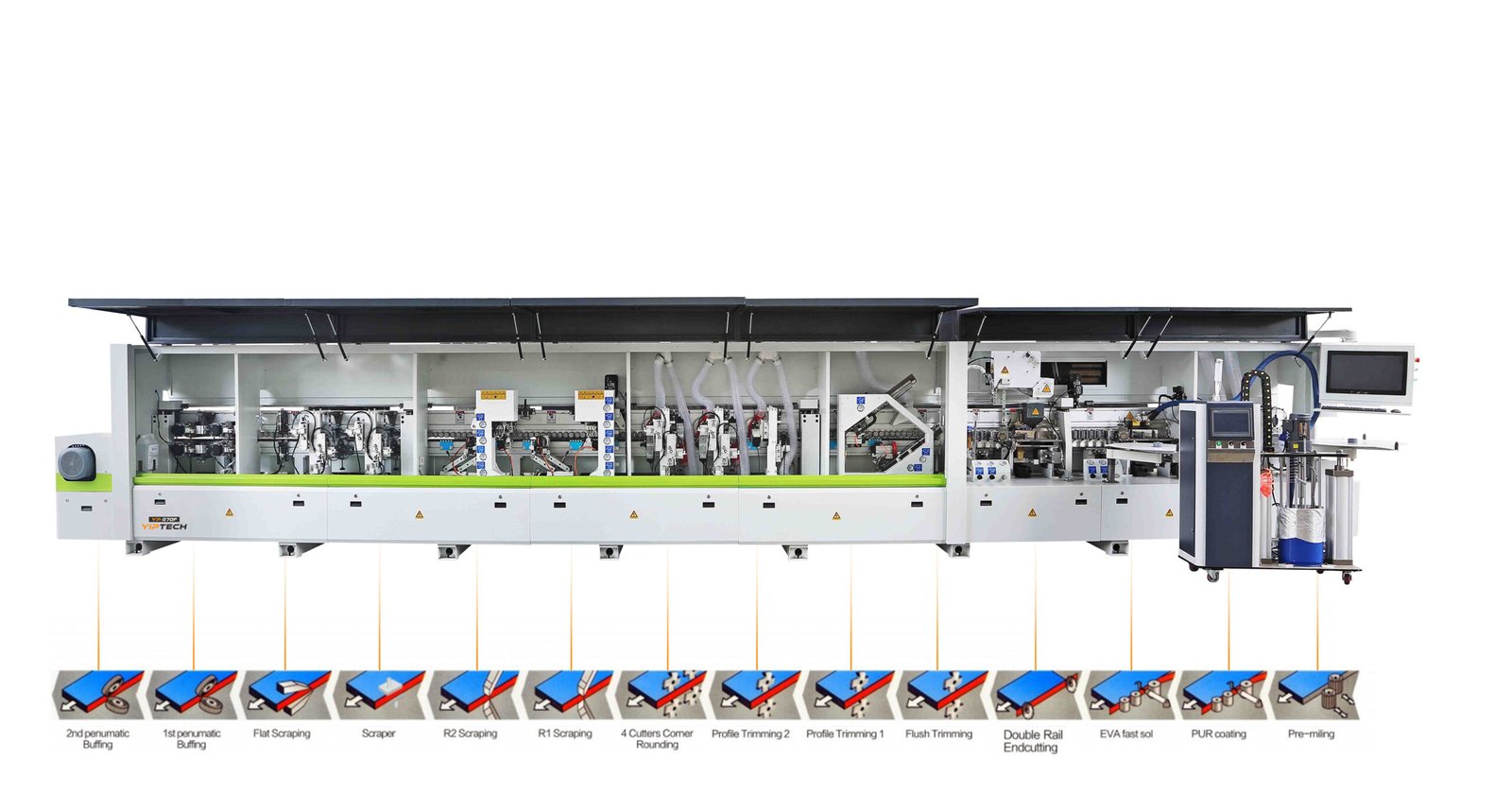
The use of PUR machines provides numerous benefits, including exceptional durability and strength, high-quality finishes, and the ability to work with a wide range of materials.
Advantages of using PUR Edge Banding Machines
- High-strength bond: PUR machines use polyurethane reactive adhesive, which creates a high-strength bond that can withstand heavy use and wear. The chemical reaction that occurs during the bonding process produces a stronger bond compared to other adhesives.
- Durability: The PUR adhesive used in PUR machines is highly resistant to heat, moisture, and chemicals, ensuring that the bond remains strong over time. This makes it ideal for applications where durability is crucial, such as in the manufacturing of kitchen and bathroom components.
- Efficiency: PUR machines can work quickly and efficiently, making them ideal for high-volume production environments. The machines are designed to apply the adhesive and banding material in one continuous process, reducing the need for manual intervention and increasing production capacity.
- Ease of use: PUR machines are user-friendly and can be easily operated by trained personnel. The machines are equipped with intuitive controls and user interfaces, making it easy to adjust settings and monitor the progress of the operation. This reduces the need for highly skilled personnel, making it more accessible to a wider range of manufacturers.
Industries and applications that benefit from using PUR Edge Banding Machines
PUR banding machines have a wide range of applications across several industries due to their high-strength bonding, durability, and resistance to heat and moisture. Here are some of the industries and applications that can benefit from using PUR machines:
- Woodworking and furniture manufacturing: PUR banding machines are commonly used in the production of high-end furniture and cabinetry, where a durable and long-lasting edge is required. The strong bond and resistance to wear and tear make it a perfect choice for furniture and cabinetry components that are subjected to heavy use.
- Automotive manufacturing: PUR machines are used in the production of car interiors, where they can provide a high-strength and heat-resistant edge for panels and components. The durability and resistance to heat and moisture make it an ideal solution for automotive components that are exposed to extreme temperatures and moisture.
- Construction industry: PUR banding machines are used in the production of building materials, such as panels and boards, to provide a strong and durable edge that can withstand the rigors of construction. The resistance to moisture and chemicals makes it an ideal solution for building materials that are exposed to harsh environmental conditions.
- Electronics manufacturing: PUR machines are used in the production of electronic components, where they can provide a high-strength and heat-resistant edge for circuit boards and other components. The strong bond and resistance to heat make it a perfect choice for electronic components that are subjected to high temperatures and stress.
Comparison between Laser and PUR Edge Banding Machines
Laser and PUR banding machines are two different technologies used for applying edges to panels and boards. While both methods offer various advantages, they also have some differences that make them better suited for specific requirements and preferences.
Similarities between Laser and PUR Banding Machines
- Both technologies can provide high-strength and long-lasting edge bonding.
- Both methods can provide a seamless edge finish that enhances the overall appearance of the finished product.
- Both technologies can work quickly and efficiently, reducing production time and increasing capacity.
Differences between Laser and PUR Banding Machines
- Process: Laser machines use a laser to melt the banding material, while PUR machines use a chemical reaction to bond the material to the panel or board.
- Cost: Laser banding machines tend to be more expensive than PUR banding machines.
- Material compatibility: Laser machines work best with materials that are highly reflective and have low thermal conductivity, while PUR machines can work with a wide range of materials.
- Environmentally friendly: PUR banding machines use less energy and produce less waste than laser banding machines.
Choosing the Right Edge Banding Machine based on Specific Requirements and Preferences
When it comes to choosing the right machine, there are several factors to consider. These factors can help determine which type of machine will be the most effective for a particular application. Some of the key factors to consider include:
- Material compatibility: Different banding machines are designed to work with specific types of materials. It is important to choose a machine that is compatible with the materials being used in the production process.
- Edge finish: The desired edge finish can also impact the choice of machine. If a smooth edge is required, a laser machine may be the best option. On the other hand, if a high-strength and durable edge is needed, a PUR machine may be the better choice.
- Production capacity: The production capacity of the machine is another important factor to consider. If a high volume of production is required, a machine with a faster production speed and greater efficiency may be necessary.
- Budget: The cost of the machine is also an important consideration. Banding machines can vary widely in price, so it is important to choose a machine that fits within the available budget.
Overall, the decision to choose between a laser and PUR banding machine will depend on the specific requirements and preferences of the application. It is important to carefully evaluate these factors to ensure that the chosen machine is the best fit for the production process.
Conclusion
Edge banding machines are critical equipment in the manufacturing industry for applying edges to panels and boards. Two common banding technologies are laser and PUR banding machines, each with its unique advantages and disadvantages. While laser machines are ideal for creating a seamless edge finish, PUR machines offer a high-strength and long-lasting bond. Ultimately, the choice of edge banding machine will depend on the specific requirements and preferences of the application.
Edge banding plays a crucial role in furniture and cabinetry manufacturing, as it not only enhances the aesthetic appearance of the finished product but also adds to its durability and strength. Choosing the right banding machine is, therefore, essential to achieving a high-quality finished product.
For further information or consultation on banding machines, YIPTECH can be contacted through their website at https://edgebandmachine.com/. They offer a wide range of banding machines and can provide expert advice to help manufacturers choose the right equipment for their specific needs.

